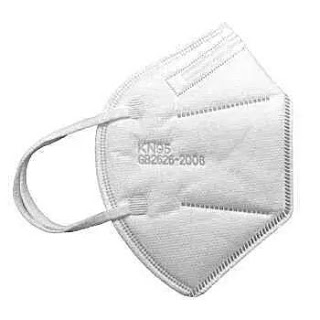How to Distinguish Between KN95 and N95 Masks: Standard Full Comparison
The origin of KN95 and N95
The product is marked as GB2626-2006 standard, KN95 type.
According to the level of filtration efficiency, the level of filtration elements, the face masks can be divided into six categories of KN90, KN95, KN100, KP90, KP95, KP100 (of which the full mask does not include KN90 and KP90). KN95 mask is a non-oily particulate filtering efficiency of more than 95% of the self-absorbing filter anti-particle respirator.
The N95 mask is certified in accordance with Appendix K-Filtered Particulate Filters of NIOSH-42CFR Part 84, Standard Certification for Respiratory Protective Equipment. Appendix K divides the filters into self-priming filtered anti-particulate respirators and air-fed filtered anti-particulate respirators. Self-priming anti-particle filter elements are divided into N, R and P according to the filtration performance, N is suitable for filtering non-oily particles, R and P are suitable for filtering oily and non-oily particles, P filter elements use longer time limit than R, R filter elements use time is generally 1 working day, P can be recommended by the manufacturer according to demand.
According to the level of filtration efficiency, the level of filter elements, the face masks can be divided into N95, N99, N100; R95, R99, R100; P95, P99, P100. N95 mask is a self-suction filtered anti-particle respirator with a filtration efficiency of more than 95% for non-oily particles.
Therefore, conceptually, both the KN95 and N95 masks are self-suction filtered anti-particle respirators with a filtration efficiency of over 95% for non-oily particles. Since the concept is the same, are the assessment indicators for both masks consistent?
Differences between KN95 and N95 key assessment indicators
China’s KN95 type mask testing is based on GB 2626-2006, with some differences in the N95 assessment indicators. See table below.
| Mask Type | Appraisal indicators |
| KN95 | Filtration efficiency, expiratory valve air tightness, respiratory resistance, visual field, headband, connections and connecting parts, lenses, leakage, dead space, air tightness, flammability, cleaning and disinfection, information provided by manufacturer, packaging. |
| N95 | Filtration efficiency, expiratory valve air tightness, breathing resistance, visual field, headband, inspiratory and expiratory valve requirements, instructions for use, parts and attributes requirements, packaging, marking. |
| Remarks | The bolding is an indicator of the increase of KN95 over N95. |
From the table above, it can be seen that KN95 and N95 have many similarities in terms of assessment indicators, such as filtration efficiency, breathing resistance, expiratory valve airtightness, field of view, headband, parts requirements, information provided by the manufacturer, packaging, etc. KN95 assessment indicators add leakage, dead space, air tightness, flammability, cleaning, and disinfection, etc.
A comparison of the requirements of KN95 and N95 key technical indicators is shown in the table below.
| Indicator | KN95 mask requirements | N95 mask requirements |
| PFE | PFE for NaCl ≥95% | PFE for NaCl ≥95% |
| Markings | GB 2626-2006 KN95 | “N95 particle filter (95% PFE level)”, marked with a color other than purple-red. |
| Respiratory resistance | Inhalation resistance ≤ 350Pa | Inhalation resistance≤35mmH2O (350Pa) |
| Breathing resistance ≤ 250Pa | Breathing resistance≤25mmH2O (250Pa) | |
| Breathing valve air tightness | ≤30mL/min | ≤30mL/min |
| Dead Space | The mean value should be no greater than 1% (dead space is the volume fraction of carbon dioxide gas re-inhaled from the previous inhalation) | The exhalation valve shall be constructed so as to prevent the effect of excess exhalation gas on the reverse of the filter media. |
| Headband | Each headband and buckle of the mask shall not slip or break when subjected to the prescribed tension. | No specific pull data requirements |
| Visual Field | Standard requirements are met | No specific requirements |
From the table above, it can be seen that there is a certain difference between the requirements of KN95 and N95 mask indicators, overall, KN95 requirements are higher.
1 The respiratory resistance requirements for KN95 masks in 1 GB 2626-2006 are consistent with N95. But note: GB 2626-2019 on the breathing resistance requirements have been adjusted, and for whether there is a breathing valve has made specific provisions, the overall requirements are higher than N95. such as the American standard with breathing valve N95 breathing resistance requirements are lower than 250 Pa, while KN95 requirements are lower than 150 Pa, a 40% drop. Therefore, the KN95, which meets the new standard, is better than the N95 in terms of comfort.
2 KN95 masks, the headband is subjected to a tensile strength test, while the N95 masks have no specific requirements for the headband to meet the tensile strength value.
3 The KN95 mask has specific numerical requirements for dead space and visual field, while the N95 does not.
Differences in testing methods between KN95 and N95 key assessment indicators
1 KN95 vs. N95 filtration efficiency pretreatment and sample size comparison
| Mask Type | Pre-treatment | Sample Size |
| KN95 | 1 Temperature and humidity pretreatment (38±2.5)℃, (85±5)% RH, placed (24±1)H (70±3)℃, dry ENV, placed (24±1)H (-30±3)℃, dry ENV, placed (24±1)H 2 Mechanical strength pretreatment | 15 disposable masks, 10 original, 5 pretreated with temp and humidity. 20 replaceable filter elements, 5 additional samples pre-treated with mechanical strength. |
| N95 | (38±2.5)℃, (85±5)% RH, placed (25±1)H | 20 |
As can be seen from the table above, in the filtration efficiency test, the test conditions are the same, but in the sample pretreatment, the KN95 is more complex and more demanding than the N95 procedure, which puts higher requirements on the filtration efficiency of the mask.
2 Comparison of KN95 and N95 breathing resistance and expiratory valve air tightness test parameters
| Parameters | Mask Type | Sample size and pretreatment | Test Conditions |
| Respiratory Resistance | KN95 | 4 samples, 2 original samples, 2 pretreated samples by temperature and humidity. | Airflow (85±1)L/min |
| N95 | Unspecified | Airflow (85±2)L/min | |
| Breathing valve air tightness | KN95 | 4 samples, 2 original samples, 2 pretreated samples by temperature and humidity. | The exhalation valve sample is airtightly sealed to the exhalation valve test fixture, subjecting the exhalation valve to a pressure of -249Pa. |
| N95 | Unspecified | Breathing valve and seat, in normal operating condition, at a negative pressure of 25mmH2O (-245Pa). |
It can be seen from the table above that, in the testing of two indicators of breathing resistance and expiratory valve air tightness test, KN95 and N95 are basically the same, but KN95, in addition to testing untreated samples, but also testing pre-treated samples, the evaluation of these two indicators of the mask more comprehensive and accurate.
By comparing KN95 and N95 masks corresponding to the testing standards, it can be found that KN95 masks and N95 masks in particle filtration efficiency, breathing resistance, expiratory valve air tightness and other key indicators are consistent with the requirements. However, the KN95 masks require more complex and demanding pre-treatment conditions during the testing process, and there are specific numerical requirements for headband tension, connection and joint components, dead space, field of view and other indicators, while the N95 mask does not.
Overall, KN95 masks are more demanding and more comprehensive than N95 masks, as long as the KN 95 masks that meet standard GB2626 requirements are better than the N95 masks that meet standard NIOSH – 42CFR Part 84.
Also, if you want to know the difference between protective masks GB 2626 and EN 149, check out this article: Face Masks, GB 2626-2019 and EN 149: 2001 + A1: 2009, Standards Comparison
Buy Medical Face Mask Machine, used to produce disposable medical face masks or surgical face masks in mass production.



评论
发表评论